In each of the following, one of the six trigonometric ratios is given. Find the values of the other trigonometric ratios.
(i) $\sin A=\frac{2}{3}$
(ii) $\cos A=\frac{4}{5}$
(iii) $\tan \theta=11$
(iv) $\sin \theta=\frac{11}{15}$
(v) $\tan \alpha=\frac{5}{12}$
(vi) $\sin \theta=\frac{\sqrt{3}}{2}$
(vii) $\cos \theta=\frac{7}{25}$
(viii) $\tan \theta=\frac{8}{15}$
(ix) $\cot \theta=\frac{12}{5}$
(x) $\sec \theta=\frac{13}{5}$
(xi) $\operatorname{cosec} \theta=\sqrt{10}$
(xii) $\cos \theta=\frac{12}{15}$
(i) Given: $\sin A=\frac{2}{3}$
By definition,
$\sin A=\frac{\text { Perpendiular }}{\text { Hypotenuse }}$
By Comparing (1) and (2)
We get,
Perpendicular side = 2 and
Hypotenuse = 3
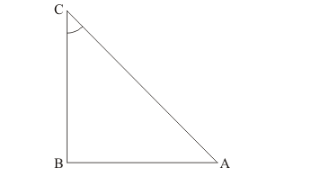
Therefore, by Pythagoras theorem,
$A C^{2}=A B^{2}+B C^{2}$
Now we substitute the value of perpendicular side (BC) and hypotenuse (AC) and get the base side (AB)
Therefore,
$3^{2}=A B^{2}+2^{2}$
$A B^{2}=3^{2}-2^{2}$
$A B^{2}=5$
$A B=\sqrt{5}$
Hence, Base $=\sqrt{5}$
Now, $\cos A=\frac{\text { Base }}{\text { Hypotenuse }}$
$\cos A=\frac{\sqrt{5}}{3}$
Now, $\operatorname{cosec} A=\frac{1}{\sin A}$
Therefore,
$\operatorname{cosec} A=\frac{\text { Hypotenuse }}{\text { Perpendicular }}$
$\operatorname{cosec} A=\frac{3}{2}$
Now, $\sec A=\frac{\text { Hypotenuse }}{\text { Base }}$
Therefore,
$\sec A=\frac{3}{\sqrt{5}}$
Now, $\tan A=\frac{\text { Perpendicular }}{\text { Base }}$
Therefore,
$\tan A=\frac{2}{\sqrt{5}}$
Now, $\cot A=\frac{\text { Base }}{\text { Perpendicular }}$
Therefore,
$\cot A=\frac{\sqrt{5}}{2}$
(ii) Given: $\cos A=\frac{4}{5}$....(1)
By definition,
$\cos A=\frac{\text { Base }}{\text { Hypotenuse }}$....(2)
By Comparing (1) and (2)
We get,
Base = 4 and
Hypotenuse = 5
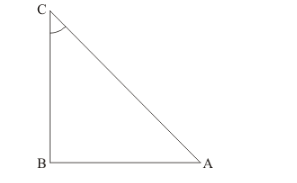
Therefore,
By Pythagoras theorem,
$A C^{2}=A B^{2}+B C^{2}$
Now we substitute the value of base side (AB) and hypotenuse (AC) and get the perpendicular side (BC)
$5^{2}=4^{2}+B C^{2}$
$B C^{2}=5^{2}-4^{2}$
$B C^{2}=25-16$
$B C^{2}=9$
$B C=3$
Hence, Perpendicular side = 3
Now, $\sin A=\frac{\text { Perpendicular }}{\text { Hypotenuse }}$
Therefore,
$\sin A=\frac{3}{5}$
Now, $\operatorname{cosec} A=\frac{1}{\sin A}$
Therefore,
$\therefore \operatorname{cosec} A=\frac{\text { Hypotenuse }}{\text { Perpendicular }}$
$\operatorname{cosec} A=\frac{5}{3}$
Now, $\sec A=\frac{1}{\cos A}$
Therefore,
$\sec A=\frac{\text { Hypotenuse }}{\text { Base }}$
$\sec A=\frac{5}{4}$
Now, $\tan A=\frac{\text { Perpendicular }}{\text { Base }}$
Therefore,
$\tan A=\frac{3}{4}$
Now, $\cot A=\frac{1}{\tan \mathrm{A}}$
Therefore,
$\cot A=\frac{\text { Base }}{\text { Perpendicular }}$
$\cot A=\frac{4}{3}$
(iii) Given: $\tan \theta=\frac{11}{1}$....(1)
By definition,
$\tan \theta=\frac{\text { Perpendicular }}{\text { Base }}$
By Comparing (1) and (2)
We get,
Base = 1 and
Perpendicular side = 5
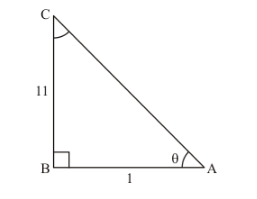
Therefore,
By Pythagoras theorem,
$A C^{2}=A B^{2}+B C^{2}$
Now we substitute the value of base side (AB) and the perpendicular side (BC) and get hypotenuse (AC)
$A C^{2}=1^{2}+11^{2}$
$A C^{2}=1+121$
$A C^{2}=122$
$A C=\sqrt{122}$
Hence, Hypotenuse $=\sqrt{122}$
Now, $\sin \theta=\frac{\text { Perpendicular }}{\text { Hypotenuse }}$
Therefore,
$\sin \theta=\frac{11}{\sqrt{122}}$
Now, $\operatorname{cosec} \theta=\frac{1}{\sin \theta}$
Therefore,
$\operatorname{cosec} \theta=\frac{\text { Hypotenuse }}{\text { Perpendicular }}$
$\operatorname{cosec} \theta=\frac{\sqrt{122}}{11}$
Now, $\cos \theta=\frac{\text { Base }}{\text { Hypotenuse }}$
Therefore,
$\cos \theta=\frac{1}{\sqrt{122}}$
Now, $\sec \theta=\frac{1}{\cos \theta}$
Therefore,
$\sec \theta=\frac{\text { Hypotenuse }}{\text { Base }}$
$\sec \theta=\frac{\sqrt{122}}{1}$
$\sec \theta=\sqrt{122}$
Now, $\cot \theta=\frac{1}{\tan \theta}$
Therefore,
$\cot \theta=\frac{\text { Base }}{\text { Perpendicular }}$
$\cot \theta=\frac{1}{11}$
(iv) Given: $\sin \theta=\frac{11}{15}$....(1)
By definition,
$\sin \theta=\frac{\text { Perpendiular }}{\text { Hypotenuse }}$....(2)
By Comparing (1) and (2)
We get,
Perpendicular side = 11 and
Hypotenuse = 15
Therefore,
By Pythagoras theorem,
$A C^{2}=A B^{2}+B C^{2}$
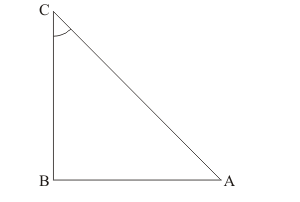
Now we substitute the value of perpendicular side (BC) and hypotenuse(AC) and get the base side (AB)
$15^{2}=A B^{2}+11^{2}$
$A B^{2}=15^{2}-11^{2}$
$A B^{2}=225-121$
$A B^{2}=104$
$A B=\sqrt{104}$
$A B=\sqrt{2 \times 2 \times 2 \times 13}$
$A B=2 \sqrt{2 \times 13}$
$A B=2 \sqrt{26}$
Hence, Base $=2 \sqrt{26}$
Now, $\cos \theta=\frac{\text { Base }}{\text { Hypotenuse }}$
Therefore,
$\cos \theta=\frac{2 \sqrt{26}}{15}$
Now, $\operatorname{cosec} \theta=\frac{1}{\sin \theta}$
Therefore,
$\operatorname{cosec} \theta=\frac{\text { Hypotenuse }}{\text { Perpendicular }}$
$\operatorname{cosec} \theta=\frac{15}{11}$
Now, $\sec \theta=\frac{\text { Hypotenuse }}{\text { Base }}$
Therefore,
$\sec \theta=\frac{15}{2 \sqrt{26}}$
Now, $\tan \theta=\frac{\text { Perpendicular }}{\text { Base }}$
Therefore,
$\tan \theta=\frac{11}{2 \sqrt{26}}$
Now, $\cot \theta=\frac{\text { Base }}{\text { Perpendicular }}$
Therefore,
$\cot \theta=\frac{2 \sqrt{26}}{11}$
(v) Given: $\tan \alpha=\frac{5}{12}$.....(1)
By definition,
$\tan \alpha=\frac{\text { Perpendicular }}{\text { Base }}$....(2)
By Comparing (1) and (2)
We get,
Base = 12 and
Perpendicular side = 5
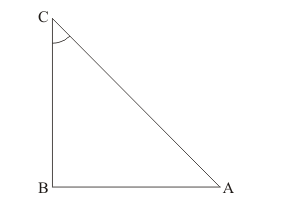
Therefore,
By Pythagoras theorem,
$A C^{2}=A B^{2}+B C^{2}$
Now we substitute the value of base side (AB) and the perpendicular side (BC) and get hypotenuse (AC)
$A C^{2}=12^{2}+5^{2}$
$A C^{2}=144+25$
$A C^{2}=169$
$A C=13$
Hence, Hypotenuse = 13
Now, $\sin \alpha=\frac{\text { Perpendicular }}{\text { Hypotenuse }}$
Therefore,
$\sin \alpha=\frac{5}{13}$
Now, $\operatorname{cosec} \alpha=\frac{1}{\sin \alpha}$
Therefore,
$\operatorname{cosec} \alpha=\frac{\text { Hypotenuse }}{\text { Perpendicular }}$
$\operatorname{cosec} \alpha=\frac{13}{5}$
Now, $\cos \alpha=\frac{\text { Base }}{\text { Hypotenuse }}$
Therefore,
$\cos \alpha=\frac{12}{13}$
Now, $\sec \alpha=\frac{1}{\cos \alpha}$
Therefore,
$\sec \alpha=\frac{\text { Hypotenuse }}{\text { Base }}$
$\sec \alpha=\frac{13}{12}$
Now, $\cot \alpha=\frac{1}{\tan \alpha}$
Therefore,
$\cot \alpha=\frac{\text { Base }}{\text { Perpendicular }}$
$\cot \alpha=\frac{12}{5}$
(vi) Given: $\sin \theta=\frac{\sqrt{3}}{2}$....(1)
By definition,
$\sin \theta=\frac{\text { Perpendiular }}{\text { Hypotenuse }}$....(2)
By Comparing (1) and (2)
We get,
Perpendicular side = ![]() and
and
Hypotenuse = 2
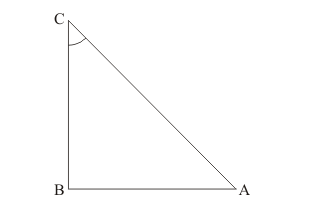
Therefore,
By Pythagoras theorem,
$A C^{2}=A B^{2}+B C^{2}$
Now we substitute the value of perpendicular side (BC) and hypotenuse(AC) and get the base side (AB)
$2^{2}=A B^{2}+(\sqrt{3})^{2}$
$A B^{2}=2^{2}-(\sqrt{3})^{2}$
$A B^{2}=4-3$
$A B^{2}=1$
$A B=\sqrt{1}$
$A B=1$
Hence, Base $=1$
Now, $\cos \theta=\frac{\text { Base }}{\text { Hypotenuse }}$
Therefore,
$\cos \theta=\frac{1}{2}$
Now, $\operatorname{cosec} \theta=\frac{1}{\sin \theta}$
Therefore,
$\operatorname{cosec} \theta=\frac{\text { Hypotenuse }}{\text { Perpendicular }}$
$\operatorname{cosec} \theta=\frac{2}{\sqrt{3}}$
Now, $\sec \theta=\frac{\text { Hypotenuse }}{\text { Base }}$
Therefore,
$\sec \theta=\frac{2}{1}$
Now, $\tan \theta=\frac{\text { Perpendicular }}{\text { Base }}$
Therefore,
$\tan \theta=\frac{\sqrt{3}}{1}$
Now, $\cot \theta=\frac{\text { Base }}{\text { Perpendicular }}$
Therefore,
$\cot \theta=\frac{1}{\sqrt{3}}$
(vii) Given: $\cos \theta=\frac{7}{25}$.....(1)
By definition,
$\cos \theta=\frac{\text { Base }}{\text { Hypotenuse }}$....(2)
By Comparing (1) and (2)
We get,
Base = 7 and
Hypotenuse = 25
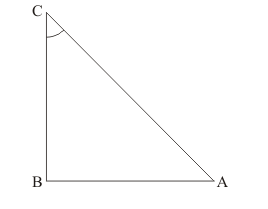
Therefore,
By Pythagoras theorem,
$A C^{2}=A B^{2}+B C^{2}$
Now we substitute the value of base side (AB) and hypotenuse (AC) and get the perpendicular side (BC)
$25^{2}=7^{2}+B C^{2}$
$B C^{2}=25^{2}-7^{2}$
$B C^{2}=625-49$
$B C^{2}=576$
$B C=\sqrt{576}$
$B C=24$
Hence, Perpendicular side = 24
Now, $\sin \theta=\frac{\text { Perpendicular }}{\text { Hypotenuse }}$
Therefore,
$\sin \theta=\frac{24}{25}$
Now, $\operatorname{cosec} \theta=\frac{1}{\sin \theta}$
Therefore,
$\operatorname{cosec} \theta=\frac{\text { Hypotenuse }}{\text { Perpendicular }}$
$\operatorname{cosec} \theta=\frac{25}{24}$
Now, $\sec \theta=\frac{1}{\cos \theta}$
Therefore,
$\sec \theta=\frac{\text { Hypotenuse }}{\text { Base }}$
$\sec \theta=\frac{25}{7}$
Now, $\tan \theta=\frac{\text { Perpendicular }}{\text { Base }}$
Therefore,
$\tan \theta=\frac{24}{7}$
Now, $\cot \theta=\frac{1}{\tan \theta}$
Therefore,
$\cot \theta=\frac{\text { Base }}{\text { Perpendicular }}$
$\cot \theta=\frac{7}{24}$
(viii) Given: $\tan \theta=\frac{8}{15}$.....(1)
By definition,
$\tan \theta=\frac{\text { Perpendicular }}{\text { Base }}$....(2)
By Comparing (1) and (2)
We get,
Base = 15 and
Perpendicular side = 8
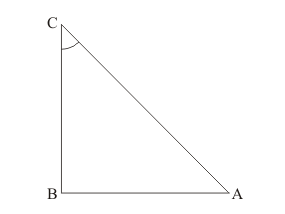
Therefore,
By Pythagoras theorem,
$A C^{2}=A B^{2}+B C^{2}$
Now we substitute the value of base side (AB) and the perpendicular side (BC) and get hypotenuse (AC)
$A C^{2}=15^{2}+8^{2}$
$A C^{2}=225+64$
$A C^{2}=289$
$A C=\sqrt{289}$
$A C=17$
Hence, Hypotenuse $=17$
Now, $\sin \theta=\frac{\text { Perpendicular }}{\text { Hypotenuse }}$
Therefore,
$\sin \theta=\frac{8}{17}$
Now, $\operatorname{cosec} \theta=\frac{1}{\sin \theta}$
Therefore,
$\operatorname{cosec} \theta=\frac{\text { Hypotenuse }}{\text { Perpendicular }}$
$\operatorname{cosec} \theta=\frac{17}{8}$
Now, $\cos \theta=\frac{\text { Base }}{\text { Hypotenuse }}$
Therefore,
$\cos \theta=\frac{15}{17}$
Now, $\sec \theta=\frac{1}{\cos \theta}$
Therefore,
$\sec \theta=\frac{\text { Hypotenuse }}{\text { Base }}$
$\sec \theta=\frac{17}{15}$
Now, $\cot \theta=\frac{1}{\tan \theta}$
Therefore,
$\cot \theta=\frac{\text { Base }}{\text { Perpendicular }}$
$\cot \theta=\frac{15}{8}$
(ix) Given: $\cot \theta=\frac{12}{5}$....(1)
By definition,
$\cot \theta=\frac{1}{\tan \theta}$.....(2)
$\cot \theta=\frac{\text { Base }}{\text { Perpendicular }}$
By Comparing (1) and (2)
We get,
Base = 12 and
Perpendicular side = 5
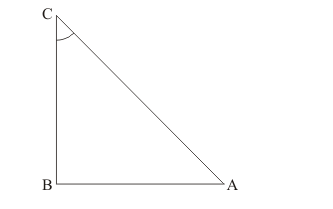
Therefore,
By Pythagoras theorem,
$A C^{2}=A B^{2}+B C^{2}$
Now we substitute the value of base side (AB) and the perpendicular side (BC) and get hypotenuse (AC)
$A C^{2}=12^{2}+5^{2}$
$A C^{2}=144+25$
$A C^{2}=169$
$A C=\sqrt{169}$
$A C=13$
Hence, Hypotenuse = 13
Now, $\sin \theta=\frac{\text { Perpendicular }}{\text { Hypotenuse }}$
Therefore,
$\sin \theta=\frac{5}{13}$
Now, $\operatorname{cosec} \theta=\frac{1}{\sin \theta}$
Therefore,
$\operatorname{cosec} \theta=\frac{\text { Hypotenuse }}{\text { Perpendicular }}$
$\operatorname{cosec} \theta=\frac{13}{5}$
Now, $\cos \theta=\frac{\text { Base }}{\text { Hypotenuse }}$
Therefore,
$\cos \theta=\frac{12}{13}$
Now, $\sec \theta=\frac{1}{\cos \theta}$
Therefore,
$\sec \theta=\frac{\text { Hypotenuse }}{\text { Base }}$
$\sec \theta=\frac{13}{12}$
Now, $\tan \theta=\frac{1}{\cot \theta}$
Therefore,
$\tan \theta=\frac{\text { Perpendicular }}{\text { Base }}$
$\tan \theta=\frac{5}{12}$
(x) Given: $\sec \theta=\frac{13}{5}$.....(1)
By definition,
$\sec \theta=\frac{1}{\cos \theta}$.....(2)
$\sec \theta=\frac{\text { Hypotenuse }}{\text { Base }}$
By Comparing (1) and (2)
We get,
Base = 5 and
Hypotenuse = 13
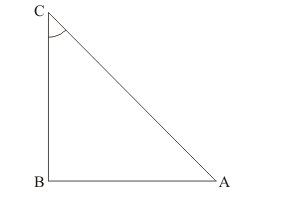
Therefore,
By Pythagoras theorem,
$A C^{2}=A B^{2}+B C^{2}$
Now we substitute the value of base side (AB) and hypotenuse (AC) and get the perpendicular side (BC)
$13^{2}=5^{2}+B C^{2}$
$B C^{2}=13^{2}-5^{2}$
$B C^{2}=169-25$
$B C^{2}=144$
$B C=\sqrt{144}$
$B C=12$
Hence, Perpendicular side = 12
Now, $\sin \theta=\frac{\text { Perpendicular }}{\text { Hypotenuse }}$
Therefore,
$\sin \theta=\frac{12}{13}$
Now, $\operatorname{cosec} \theta=\frac{1}{\sin \theta}$
Therefore,
$\operatorname{cosec} \theta=\frac{\text { Hypotenuse }}{\text { Perpendicular }}$
$\operatorname{cosec} \theta=\frac{13}{12}$
Now, $\cos \theta=\frac{1}{\sec \theta}$
Therefore,
$\cos \theta=\frac{\text { Base }}{\text { Hypotenuse }}$
$\cos \theta=\frac{5}{13}$
Now, $\tan \theta=\frac{\text { Perpendicular }}{\text { Base }}$
Therefore,
$\tan \theta=\frac{12}{5}$
Now, $\cot \theta=\frac{1}{\tan \theta}$
Therefore,
$\cot \theta=\frac{\text { Base }}{\text { Perpendicular }}$
$\cot \theta=\frac{5}{12}$
(xi) Given:
$\operatorname{cosec} \theta=\sqrt{10}$....(1)
$\operatorname{cosec} \theta=\frac{\text { Hypotenuse }}{\text { Perpendicular }}$
By Comparing (1) and (2)
We get,
Perpendicular side = 1 and
Hypotenuse $=\sqrt{10}$
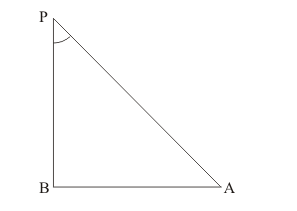
Therefore,
By Pythagoras theorem,
$A C^{2}=A B^{2}+B C^{2}$
Now we substitute the value of perpendicular side (BC) and hypotenuse (AC) and get the base side (AB)
$(\sqrt{10})^{2}=A B^{2}+1^{2}$
$A B^{2}=(\sqrt{10})^{2}-1^{2}$
$A B^{2}=10-1$
$A B^{2}=9$
$A B=\sqrt{9}$
$A B=3$
Hence, Base side = 3
Now, $\sin \theta=\frac{\text { Perpendicular }}{\text { Hypotenuse }}$
Therefore,
$\sin \theta=\frac{1}{\sqrt{10}}$
Now, $\cos \theta=\frac{\text { Base }}{\text { Hypotenuse }}$
Therefore,
$\cos \theta=\frac{3}{\sqrt{10}}$
Now, $\sec \theta=\frac{1}{\cos \theta}$
Therefore,
$\sec \theta=\frac{\text { Hypotenuse }}{\text { Base }}$
$\sec \theta=\frac{\sqrt{10}}{3}$
Now, $\tan \theta=\frac{\text { Perpendicular }}{\text { Base }}$
Therefore,
$\tan \theta=\frac{1}{3}$
Now, $\cot \theta=\frac{1}{\tan \theta}$
Therefore,
$\cot \theta=\frac{\text { Base }}{\text { Perpendicular }}$
$\cot \theta=\frac{3}{1}$
$\cot \theta=3$
(xii) Given: $\cos \theta=\frac{12}{15}$....(1)
By definition,
$\cos \theta=\frac{\text { Base }}{\text { Hypotenuse }}$.....(2)
By Comparing (1) and (2)
We get,
Base = 12 and
Hypotenuse = 15
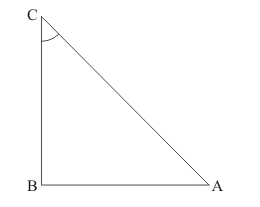
Therefore,
By Pythagoras theorem,
$A C^{2}=A B^{2}+B C^{2}$
Now we substitute the value of base side (AB) and hypotenuse (AC) and get the perpendicular side (BC)
$15^{2}=12^{2}+B C^{2}$
$B C^{2}=15^{2}-12^{2}$
$B C^{2}=225-144$
$B C^{2}=81$
$B C=\sqrt{81}$
$B C=9$
Hence, Perpendicular side = 9
Now, $\sin \theta=\frac{\text { Perpendicular }}{\text { Hypotenuse }}$
Therefore,
$\sin \theta=\frac{9}{15}$
Now, $\operatorname{cosec} \theta=\frac{1}{\sin \theta}$
Therefore,
$\operatorname{cosec} \theta=\frac{\text { Hypotenuse }}{\text { Perpendicular }}$
$\operatorname{cosec} \theta=\frac{15}{9}$
Now, $\sec \theta=\frac{1}{\cos \theta}$
Therefore,
$\sec \theta=\frac{\text { Hypotenuse }}{\text { Base }}$
$\sec \theta=\frac{15}{12}$
Now, $\tan \theta=\frac{\text { Perpendicular }}{\text { Base }}$
Therefore,
$\tan \theta=\frac{9}{12}$
Now, $\cot \theta=\frac{1}{\tan \theta}$
Therefore,
$\cot \theta=\frac{\text { Base }}{\text { Perpendicular }}$
$\cot \theta=\frac{12}{9}$
Click here to get exam-ready with eSaral
For making your preparation journey smoother of JEE, NEET and Class 8 to 10, grab our app now.
